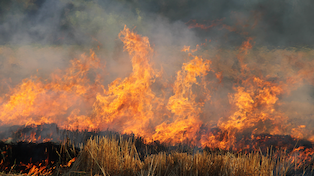In years past, wildfire season was largely thought of as a summer peril; however, the effects of climate change have many experts changing their tune by calling it a year-round concern. With that in mind, the threat of wildfires still looms over many homeowners’ heads during the hot, dry summer months. Wildfires are unpredictable and containing them can be extremely challenging once they start, burning through land and buildings quickly. This leaves not only destruction in their wake, but also hefty repair bills for homeowners.
The U.S. experiences an average of almost 60,000 wildfires per year, which burned 7.6 million acres of land on average between 2018 and 2023 according to the National Interagency Fire Center. A recent State Farm report estimates that 4.5 million homes are located in areas at high risk for a wildfire. Since wildfires can impact almost anyone, it’s important to prepare for the physical, emotional and financial toll they can have on our homes and communities.
Intensifying Heat, Longer Summers and Drier Climate Fuel More Active Fire Seasons
First things first, it’s important to note that wildfires are essential when it comes to a forest’s and rangeland’s health. Fires eliminate dead leaves and branches, all while adding nutrients to the soil and can even help some plants sprout.
According to the United States Geological Survey (USGS), wildfires have become more destructive and impactful throughout the country in the last few years due to drier soil and vegetation and climate change with warmer springs and longer summers. The USGS also notes that climate conditions – especially within the western parts of the United States – have become increasingly hotter over the last several decades. And, if we continue this course, the EPA explains that also means longer wildfire seasons, greater wildfire frequency and more burned areas.
While wildfires are often thought of as natural disasters that happen in the west, The U.S. Drought Monitor indicates that areas of the Midwest and the Northeast can also face high risks of fire because of drought conditions. That means that no one is immune to the devastating effects of wildfires, which is all the more reason why homeowners need to have plans in place to protect their wellbeing and their pocketbooks.
Prepare for What Mother Nature Throws Your Way
Before disaster strikes, homeowners need to be on top of ways to mitigate the risk and damage of wildfires. We rounded up our top tips to start creating an emergency plan to be prepared for wildfire season.
- Stay informed: Step one should always be to stay on top of the current conditions near you. Closely following weather forecasts, official warnings and fire danger ratings are just a few ways to know what’s happening in your area. Folks can also sign up for emergency alerts to receive real-time update on incidents and evacuations in a timely manner, in case they need to act quickly.
- Reduce risk outside of your home: Maintaining a safe zone around your house by clearing vegetation outside can help slow down the spread of wildfire. Other ways to impede flames include:
- Removing dead plants, dry leaves, and tree branches that can catch fire quickly within 30 feet of the home
- Trimming trees regularly so they’re a safe distance from the roof
- Storing flammable materials like firewood, gas or propane away from the house
- Hardscaping or xeriscaping your lawn with gravel, concrete or stone patios and paths
- Mitigate risk within your home: Homeowners who live in high-risk areas can make upgrades to reduce the risk of wildfires spreading quickly in their home, such as:
- Installing fire-resistant materials like non-combustible roofing and siding
- Covering vents with mesh screens to keep embers out
- Swapping in dual-pane or tempered glass alternatives for single-pane windows
- Keeping fire extinguishers on hand so you and your family can access them easily
- Develop an evacuation plan: Having a well-thought-out evacuation plan is essential for keeping your family safe amid a natural disaster. That’s why you should start by identifying various evacuation routes and ensure all family members know them, along with establishing a designated meeting spot outside the danger zone if you get separated. Don’t forget to account for any pets you may have as well.
- Purchase disaster insurance: Consider adding a disaster insurance policy from Recoop into your plan to provide access to quick, flexible recovery funds. The no-strings-attached cash is there for you to use as you see fit, like covering the cost of temporary housing, childcare or home repairs as you put the pieces back together after a wildfire.
Whether you live in a high- or low-risk area, you can never be too cautious when it comes to preparing for a wildfire. Safeguard your home and bank account by taking proactive steps to temper the risk and impact of a wildfire and give yourself peace of mind.

